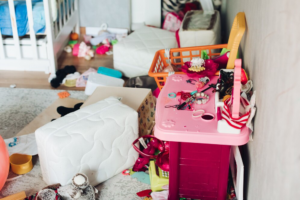
In homes where the walls breathe behind forgotten boxes and time is counted in unopened stacks of papers, a silent overwhelm builds. It creeps quietly until movement feels like negotiation, and every step requires a mental debate. These are not just messy houses but spaces where memories and burdens pile high. When a hoarder home reaches that critical tipping point, action becomes survival.
No one truly prepares for the emotional weight of a cleanout. It’s not about trash; it’s about unraveling a life layered in fear, comfort, or avoidance. Each object holds meaning. Each decision takes energy. That’s where a thoughtful and strategic cleanout enters. Not with force, but with structure. It begins with understanding the depth before lifting a single thing.
Understanding the Hidden Complexity of Hoarder Spaces
A hoarder home is a world within itself, where each item serves a deeper, often unseen purpose. These homes are not merely cluttered; they are layered with memories, emotions, and personal histories that most people can’t easily understand. What appears to be a disorganized mess to an outsider is, in fact, a carefully constructed fortress of comfort for the individual living there. The stacks of boxes, piles of newspapers, and forgotten trinkets hold immense sentimental value, each piece linked to moments of the past that offer a sense of security.
For the person inside, these objects represent stability in an otherwise chaotic world. Hoarder cleanouts involve more than just clearing a space; they require a deeper understanding of the psychological and emotional forces at play. The process demands patience, compassion, and respect for the journey the person has taken to accumulate these items. Successful cleanouts acknowledge this emotional connection, allowing for healing and resolution as the physical space is restructured.

Why Hoarder Home Cleanouts Require More Than Just Elbow Grease
When faced with the daunting task of cleaning out a hoarder home, many are tempted to dive right in, armed with trash bags and a sense of determination. However, this approach can quickly backfire. Hoarder homes require more than enthusiasm—they demand a delicate balance of patience, strategy, and expertise. Items are often hidden under layers of clutter, and many have sentimental value that can’t be discarded without careful consideration. In addition to sorting through piles, there are health risks to consider.
The accumulation of dust, mold, and even animal waste can create an environment hazardous to your health. Floors and structural integrity may also be compromised by years of weight bearing down on them. A professional team doesn’t simply provide muscle; they bring a structured approach to sorting, protecting valuables, and disposing of waste properly. This system ensures that nothing is missed, preserving both valuable items and the safety of the individuals involved in the cleanout.
Health Hazards That Lurk Beneath the Surface in Hoarder Cleanouts
The visible clutter in a hoarder home can be overwhelming, but the real dangers often lie beneath the surface. Mold, mildew, and bacteria thrive in spaces that aren’t properly ventilated or maintained, creating significant health risks. Some rooms may harbor animal waste or rotting food, while other areas might be filled with expired chemicals or old cleaning supplies that have deteriorated over time. Without proper protective gear, such as respirators and gloves, exposure to these hidden dangers can lead to respiratory issues, skin irritation, and allergic reactions.
In addition to biological risks, there are structural threats to the home itself. Years of accumulated items can weaken floors and compromise the integrity of walls and ceilings. Stairways and hallways may be so obstructed that they become dangerous to navigate. Professional teams are trained to recognize these hazards and take the necessary precautions, ensuring a safe and thorough cleanout process that reduces health risks and safeguards everyone involved.
Emotional Resistance and How It Impacts the Cleanout Process
Perhaps the most difficult challenge in a hoarder cleanout is not the clutter but the emotional resistance from the individual who has accumulated it. Hoarding is often a response to trauma, anxiety, or a deep-seated fear of loss. The items stored in the home are not just objects; they are anchored to the past, to memories, and to a sense of control over an otherwise chaotic world. Asking someone to part with these items can feel like asking them to let go of a part of themselves. The emotional resistance can manifest as defensiveness, denial, or even anger.
That’s why a cleanout must be approached with deep empathy and understanding. Professionals are trained to handle these emotions with care, allowing the person to process their feelings at their own pace. Rather than forcing the individual to make decisions quickly, the process is about creating a safe space where the resident feels heard and respected. This emotional pacing is key to ensuring the success of the cleanout and fostering a long-term, sustainable solution.
How Planning Prevents Burnout and Chaos During Hoarder Cleanouts
Without a clear plan, the task of cleaning out a hoarder home can quickly become overwhelming, leading to burnout and frustration. The sheer magnitude of the project can feel like an insurmountable task, with every room filled to the brim with years of accumulation. However, with proper planning, the process becomes more manageable. A comprehensive strategy includes assessing the space, identifying what can be salvaged, what needs to be discarded, and what is potentially hazardous.
Segmentation is a key aspect of this process—breaking the home into zones allows the team to focus on one area at a time, reducing the feeling of being overwhelmed. This methodical approach not only provides a sense of control but also helps avoid burnout by creating smaller, achievable goals. Each room cleared offers visible progress, which motivates both the cleaning team and the resident. Planning also takes into account the emotional pacing of the cleanout, ensuring that decisions are made thoughtfully and in alignment with the person’s comfort level.
Tools and Techniques That Make a Real Difference in Hoarder Cleanouts
A successful hoarder cleanout isn’t just about muscle; it’s about using the right tools and techniques to navigate the chaos with precision. Basic cleaning supplies won’t cut it in a hoarder home. Specialized equipment is essential for protecting both the individuals performing the cleanout and the items being handled. Industrial-strength gloves, HEPA filter respirators, and commercial-grade vacuums are necessary for dealing with the dust, mold, and allergens that often accompany these types of cleanouts. Additionally, dumpsters, sorting bins, and trucks are all critical to the efficient removal of large quantities of waste and debris.
However, tools alone aren’t enough—technique is what truly makes a difference. A systematic approach to sorting and clearing ensures that valuable items are preserved while waste is disposed of responsibly. Each item is carefully evaluated, with sensitive materials like documents and electronics being sorted and handled with extra care. A well-organized process minimizes back-and-forth and prevents unnecessary distractions, keeping the team focused and efficient as they clear the space.
Legal and Ethical Considerations in Hoarder Home Cleanouts
When dealing with a hoarder home, it’s important to understand that the cleanout process isn’t just about removing clutter—it’s also about adhering to legal and ethical standards. Many hoarder homes are subject to local regulations, which may involve property codes, fines, or other legal implications. In some cases, the items within the home could have legal significance, particularly in the case of estates or eviction situations. This means that every decision made during a cleanout must be carefully considered, as discarding important documents or items without proper consultation can lead to serious consequences.
Additionally, proper disposal is crucial. Certain materials, such as electronics, chemicals, or biohazards, require special handling and disposal methods in accordance with environmental regulations. The ethical aspect of hoarder cleanouts also involves donating items that can still be of use, ensuring they go to a good cause rather than simply being discarded. A reputable cleanout service understands these legal and ethical considerations and ensures that all actions taken are compliant with local laws and responsible in nature.
The Role of Junk Removal Services in Reclaiming Livable Spaces
Junk removal services play a pivotal role in transforming a hoarder home back into a livable space. These services are more than just a means of clearing away clutter—they are the catalyst for change. When a team enters a hoarder home, they do more than just collect items. They provide the structure, strategy, and emotional support needed to reclaim the space, turning it from a chaotic environment into one that is functional and comfortable again.
The process involves not just the removal of objects but the careful sorting of what can be salvaged, donated, or discarded. The end result is a home that no longer feels suffocating but open, breathable, and full of potential. This transformation is profound, as it provides the individual with both physical and emotional space to heal, move forward, and start anew. Junk removal isn’t just about clearing space; it’s about restoring dignity and offering a fresh start.
Conclusion
A hoarder home cleanout is much more than a physical task—it’s an emotional journey that requires sensitivity, patience, and understanding. The process often involves navigating cluttered spaces, each item carrying its own history and significance. With the right approach, you can regain control of the environment without adding stress or pressure to an already overwhelming situation. It’s about finding balance between compassion and efficiency, respecting the emotions tied to possessions while creating a safe, organized space.
606 Junk Removal and Dumpster Rental, based in Chicago, IL, brings expertise to every step of the cleanout process. Their team is dedicated to delivering not just removal, but meaningful solutions tailored to your specific needs. Reach out today at 773-412-4902 or via email at info@606junk.com to start reclaiming your space with professional support.
